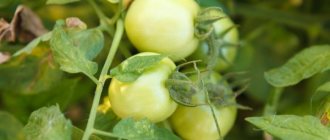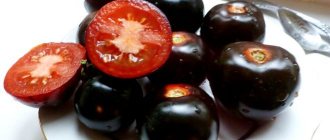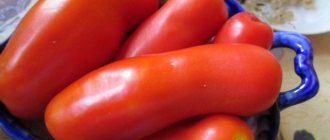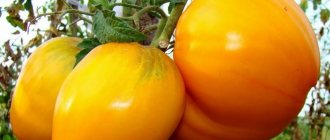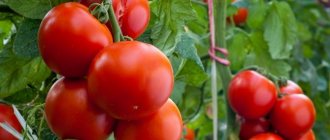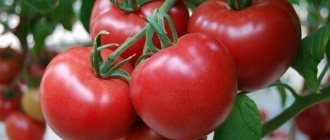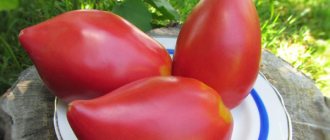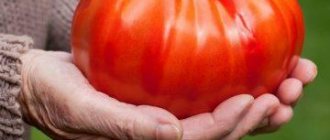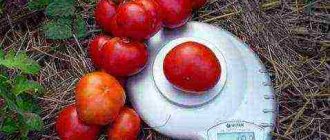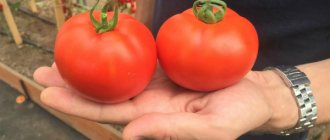Author's rating
Author of the article
Yakov Pavlovich
Professor, Head of the Department of Vegetable Growing
Articles written
153
The love for large-fruited, fleshy and sweet tomatoes is traditional for Russian vegetable growers. The tomato variety Heavyweight of Siberia satisfies the basic requirements of gardeners: it is productive, large, sweet and unpretentious. Small bushes of Siberian Heavyweight can be planted in open ground even in short, cool summer conditions.
Advantages and disadvantages
Over a dozen years of growing the variety throughout the country, vegetable growers have identified the strengths of the Siberian Heavyweight:
- cold resistance (sets fruit at a temperature of +17 +18 degrees);
- short stature;
- fleshiness and high sugar content in fruits;
- stable yield;
- the ability to collect seeds from your tomatoes for further propagation.
The disadvantages include the moisture-loving nature of tomatoes. Plants at the time of flowering and fruiting need regular watering. Drought causes flowers and ovaries to fall off.
Due to their large size, the fruits have an irregular shape and sometimes crack.
Description of the variety
Main characteristics:
- a plant with an average ripening period - produces a harvest 100–110 days after the final dive into the ground;
- determinate bushes reach a height of 60–70 cm - they need staking due to the large weight of the fruits;
- the bushes form a small number of side shoots - pinching is carried out only to increase the yield, while for the most part excess inflorescences are removed, not stems;
- leaves are medium-sized, green;
- the stem and shoots are not very strong, so they often break off before the fruits ripen;
- fruits are flattened, heart-shaped, bright red;
- the average weight of one tomato is 400–600 g;
- inside the fruit there are 4–6 chambers containing juice with seeds, the structure of which resembles jelly;
- the pulp is dense, sweet and sour - suitable for fresh consumption and for preparing tomatoes and sauces;
- You should not allow more than 8–10 fruits to form on a bush, otherwise the plant will die;
- yield per sq. m is 11–12 kg, per bush – 3–3.5 kg;
- the variety is resistant to temperature changes and does not tolerate heat well;
- tomato is resistant to late blight and most pests;
- Taking into account the large-fruited and small-sized bushes, the recommended planting scheme is no more than 4 plants per square meter. m.
Did you know? Small-fruited varieties of tomatoes are used in landscape design. They retain their decorative appearance for a long time and make interesting compositions with flower beds. They look especially impressive with the Bride and Groom plant.
Tomato Heavyweight of Siberia - description
The variety is early, the first fruits are ready for consumption 3 months after germination. This is one of the fastest ripening varieties among beef tomatoes.
Characteristics of the bush
The height of the plant is 40-50 cm, in protected soil the stem can stretch up to 80 cm. Tomato stems are strong, but they are not able to support the weight of the fruit, so a garter to a support is necessary.
The foliage of the bush is average. The leaves are light green, small in size, slightly pubescent.
Fruits and yield
Each plant produces 2-3 clusters of fruit. Tomatoes are heart-shaped or bast-shaped, with a dense pink-raspberry shell. The inside of the fruit is multi-chambered, with a high pulp content and a small amount of juice. The taste is sweet, rich.
The average weight of the fruit is 200-280 g, the first tomatoes on the bunch reach a weight of 450 g. If no more than 3-5 fruits are left on the bush, the weight of each can be 700-800 g.
The total yield of the plant is 2.5-3 kg.
Immunity to disease
The heavyweight of Siberia has innate immunity to fusarium and TMV. It does not suffer from temperature changes and tolerates high air humidity.
Pest and disease control
The variety Heavyweight of Siberia has high immunity to diseases. Plants are sprayed with fungicides 1-2 times a month. For prevention, tomatoes are treated with infusion of wormwood, onion peels or garlic. Be sure to follow the rules of agricultural technology: regulate watering or fertilizing with nitrogen, ventilate the greenhouse or greenhouse. The risk of developing diseases increases in cold and wet weather; the fungus spreads quickly in too dense plantings.
Tomatoes are susceptible to attack by whiteflies, spider mites, mole crickets and other pests. If insects are detected, the plants are treated with Iskra, Actellik or Fundazol insecticides. A solution is prepared based on the preparations and sprayed in the morning or evening. Among the folk remedies against pests, tobacco dust and wood ash are effective. Chemicals are not used 3 weeks before harvest.
What conditions does the variety require?
Siberian heavyweight is successfully grown in protected and open ground. The main thing for the plant is to ensure uninterrupted watering. Regular application of fertilizers allows the tomato to grow large fruits.
Due to the small size of the tomato, it is permissible to place 4-5 plants per 1 square meter. m. But such close planting reduces the feeding area for the bush and does not allow large fruits to fill. The recommended planting pattern for the Siberian Heavyweight is 40 by 50 cm.
See also Tomatoes Honey Spas: yield and characteristics of the variety
Features of cultivation
The Heavyweight of Siberia tomato is grown both in protected and open ground. It requires a lot of sunlight and an area protected from the wind. The land must be neutral and fertile.
You need to add the following to the soil: humus, peat, sand, ash. Component ratio: 3:1:1:1. You can place 4 bushes per 1 square meter according to the following scheme: 40 cm between plants and 50 cm between rows. In this case, regular fertilizing and timely watering will be needed.
Planting and caring for tomatoes
Like all beef tomatoes, Siberian heavyweight needs a well-lit, fertile plot of land, protected from cold winds. The field for planting tomatoes is prepared in the fall by digging up the soil and adding rotted manure (5-8 kg per 1 sq. m).
Particular attention is paid to the previous culture. Tomatoes can be planted after peas, beets, carrots, cabbage and cucumbers. It is prohibited to place them after potatoes, eggplants, peppers, and sunflowers. Sowing green manure (mustard, rye, phacelia) will help improve the soil after these plants.
Preparatory stage
Self-made Siberian Heavy seeds are pickled in a solution of Fitosporin or potassium permanganate (pink solution) for 20 minutes before sowing. The fungicide will destroy any infection that may have persisted on the seed coat.
To improve germination, the seed is soaked in Epin or a solution of aloe juice for 10-15 minutes. There is no need to rinse the seeds after soaking in stimulants.
Important! If you purchased tomato seeds coated with a colored shell (coated), no treatment is carried out. This seed is completely ready for sowing.
Many gardeners germinate tomatoes before sowing. This helps to weed out non-germinating seeds and speed up the emergence of seedlings. Tomatoes are sprouted in a humid environment at a temperature of +22 +25 degrees. In high-quality seeds, sprouts hatch in 2-3 days.
Sowing dates and patterns
Siberian Heavyweight is grown through seedlings, sowing the tomato 50 days before placing the plants in the garden. Approximate dates for sowing and planting seedlings in open ground, depending on the region:
- middle zone and Moscow region - March 15-20 and May 20-26;
- south of the country – March 1-10 and early May;
- Ural and Siberia - April 5-15 and June 10.
Tomatoes are planted in greenhouses and greenhouses 5-10 days earlier.
The Heavyweight of Siberia variety can be grown without picking by sowing the seeds in a common box. The sowing pattern is 4 by 5 cm. Due to the small size of the bush, the seedlings do not suffer from such close proximity.
Soil for the Heavyweight of Siberia is bought at a garden store or prepared with your own hands from humus, sand, peat and garden soil. Before sowing, the substrate is steamed over steam or poured with boiling water and potassium permanganate to get rid of fungal spores and weed seeds.
Transplantation into the ground
8-12 days before planting the seedlings in the garden, the seedlings must be accustomed to fresh air and sun. Tomatoes in boxes are taken out into the air, left outside for 2-4 hours, and put indoors at night. Hardening allows plants to more easily adapt to the garden after transplanting.
Tomatoes are planted in the evening so that the seedlings do not suffer from hot and dry air. Granular complex fertilizer (20 g) or humus (up to 500 g) is added to the planting hole and a support for the stem is immediately installed.
On a note. If you cover the soil under the bushes with a thick layer of dry, clean straw or hay, the bushes do not need to be tied up. The tomatoes lie on the mat, warmed by the ground, and remain clean.
The bushes are watered abundantly, and the soil under the plants is covered with straw or wood shavings. The thickness of the mulch layer is 8-10 cm. Mulching helps reduce the evaporation of water from the soil, prevents the soil from overheating, and prevents weeds from germinating.
See also Productivity and reviews of the tomato Mystery of Nature
Watering and fertilizing table
| Tomato development phase | Watering mode | Feeding mode |
| After landing in the ground | 3 times a week (soil moderately moist) | _ |
| Bloom | 3 times a week | Complex mineral fertilizer + microelements (spraying) or manure infusion + ash + iodine at the root, 1.5 liters per bush |
| Mass fruiting | 1-2 times a week | Every 2 weeks, alternating nitrogen and phosphorus-potassium fertilizers |
Water the tomatoes with cold, soft water, just at the root.
Bush formation
The heavyweight of Siberia forms a small number of lateral processes; they do not need to be removed. The strongest shoots will give an additional small harvest. But in order to achieve the filling of especially large tomatoes, no more than 5 fruits are left on the bush. Excess stepsons and ovaries (until they reach the size of a nut) should be removed.
There is no need to pinch the top of the tomato.
Preventive spraying
Due to its early ripening and natural immunity, the variety is rarely affected by diseases. But in order to completely eliminate the possibility of infection, plants are treated 2-3 times per season with Fitosporin, Baktofit, and Iskra Bio. One of the folk remedies that helps is whey (1 glass per bucket of water).
To combat harmful insects, use dusting of foliage with tobacco and ash powder and spraying with garlic water (1 cup of garlic cloves is infused in 8 liters of water for 2 days). The pungent odor repels insects and the tomatoes remain clean.
Timely weeding reduces the number of pests.
general characteristics
Working on creating a variety, agricultural breeders tried to combine several positive qualities in one plant:
- precocity;
- large fruits;
- the ability to grow tomatoes in harsh climatic conditions;
- resistance to low temperatures;
- resistance to many diseases.
And I must say that they have created a truly unique variety of its kind.
The “Heavyweight of Siberia” tomato fully justifies such an unusual name. Being an early ripening, determinate plant, it produces very large fruits. But he received great recognition for a completely different reason.
Not every variety can be grown in regions with harsh climates, either in open ground or protected ground. But “Heavyweight of Siberia” tomatoes are distinguished precisely by the fact that they bear fruit well at very modest ambient temperatures. Tomatoes produce an excellent abundant harvest when grown at temperatures up to +28˚С +30˚С; higher rates immediately affect the yield reduction.
The “Heavyweight of Siberia” tomato belongs to the group of low-growing vegetable crops. When growing tomatoes in open ground, the height of the plant barely reaches 60-70 cm. In greenhouses and greenhouses, its height can reach 80-100 cm, no more. The foliage of the bush is medium, the foliage has a rich dark green color.
Interesting! Due to the low acid content, tomatoes of the “Heavyweight of Siberia” variety are recommended for dietary nutrition.
Typically, low-growing tomato varieties do not need staking. But not “Heavyweight”. For the simple reason that its fruits reach truly gigantic sizes, the plants need to be tied up.
The tomato stem, despite its rather sonorous name, is not very powerful. The bushes often fall to one side; without a garter, the bunches break off even before the tomatoes ripen.
The creators of the variety advise tying up not only the bushes, but also the fruits so that the tassels do not break off. You can use regular supports instead of a traditional garter. Small branches in the form of a “slingshot” are placed under the heaviest brushes. This way you can protect the bushes.
According to the characteristics and description of the tomato variety “Heavyweight of Siberia,” it does not require such a mandatory event as pinching. However, to obtain larger fruits, many summer residents still prefer to occasionally remove excess shoots and form bushes with 2-3 stems.
The “Heavyweight” tomato is not a hybrid, and therefore the seeds can be prepared independently. The largest tomatoes perfectly retain their varietal characteristics. But after 4-5 years, it is still worth updating the seed material, since over time, the signs of belonging to this variety gradually disappear.
Fruit characteristics
The fruits of the “Heavyweight of Siberia” tomato reach an average weight of 400-500 grams. But to increase productivity, the following measures must be taken:
- regular feeding;
- removal of stepsons;
- bush formation;
- cupping of ovaries.
Cupping – removal of excess ovaries. There should be no more than 8-10 of them on one plant. In this case, the tomatoes will be very large - up to 800-900 grams. All forces and nutrients will go towards the growth and ripening of giant fruits.
Interesting! The word “tomato” is translated from Italian as “golden apple”.
The shape of the fruit is quite remarkable - heart-shaped, slightly flattened. The color of the tomatoes is predominantly pink, the flesh is juicy and fleshy. The tomatoes taste very sweet, with barely noticeable sourness. The number of cameras is no more than 4-6.
Tomatoes have a smooth, blemish-free surface and do not crack during the ripening process. Tomatoes “Heavyweight of Siberia” tolerate transportation well over short distances without losing their presentation. But it is best to transport them over long distances in an unripe form.
In terms of taste characteristics, size, shape and color of the fruit, “Heavyweight” is very similar to the “Alsu”, “Velmozha” and “Danko” tomatoes. All varieties belong to the agro collection.
Application area
Judging by the characteristics and description, “Heavyweight of Siberia” tomatoes are more likely to be table varieties, which determines the area of application of the fruit. They are good for slicing, summer salads, and fresh consumption.
Juices from tomatoes of this variety are thick, tasty and rich, but do not have that bright scarlet color that traditional tomato juice has.
“Heavyweight of Siberia” tomatoes are also excellent for winter preparations. And if they are unsuitable for whole-fruit canning due to their large size, then they are perfect for preparing a variety of salads, hodgepodges, sauces, and pastes as a component.
Many housewives prefer to freeze tomatoes. “Heavyweight of Siberia” can be frozen in small portions for adding to main courses in winter, for preparing a variety of casseroles and pizzas.
This tomato variety is not suitable for drying. Juicy fruits lose too much moisture during the drying process.
Interesting! At the moment, more than 10,000 varieties of tomatoes are known.
Features of cultivation
Tomatoes “Heavyweight of Siberia”, judging by the description and characteristics of the variety, are not characterized by high yield. If you follow all the rules of agricultural technology, you can harvest up to 10-11 kg of tomatoes from 1 m². The yield per bush is 3-3.5 kg.
At first glance, the yield indicators are not so great. But this disadvantage is more than compensated by the excellent taste of the fruit. It is for this reason that it has long enjoyed deserved popularity among many gardeners.
The tomato bears fruit well when grown under a film cover. Along with polyethylene, lutrasil or other non-woven materials can be used as a covering material.
A decrease in ambient temperature does not in any way affect the yield of tomatoes, which makes it especially valuable when grown in regions with a harsh climate.
But elevated temperatures can cause a decrease in the quality and quantity of the crop. Judging by the numerous reviews of summer residents who have already planted “Heavyweight of Siberia” tomatoes and were able to evaluate its taste, in cool weather the fruit set and ripening is higher than in the hot summer. This feature fully corresponds to the characteristics and description of the variety.
The taste and quality of tomatoes is influenced by the correct location for planting the “Heavyweight”. The soil should be neutral, fertile and loose, and the area should be sunny and well lit. When there is insufficient lighting, the taste of tomatoes becomes sour.
When growing low-growing tomatoes, the recommended planting scheme involves planting 6-10 plants per 1 m², but not “Heavyweight”. When growing this variety of tomatoes, you must strictly adhere to the following recommendation - no more than 4-5 bushes per 1 m². As a rule, dense plantings cause a decrease in yield.
Interesting! The debate about whether tomatoes are berries or vegetables has lasted more than 100 years. And only 15 years ago the European Union decided to call tomatoes “fruits”
Sowing seeds for seedlings
It is necessary to prepare the soil for seedlings 5-7 days before planting the seeds. For “Heavyweight” tomatoes, soil mixtures for growing tomato and pepper seedlings or garden soil with the addition of humus in a 2:1 ratio are suitable.
Tomato seeds “Heavyweight of Siberia” purchased in a store do not require pre-treatment. They can only be soaked for a day in warm, settled water with the addition of any stimulant for the formation and growth of roots.
Seed material prepared independently must be kept for 2-3 hours in a pink solution of potassium permanganate for disinfection. Subsequently, the seeds can be soaked in water or a growth stimulant.
Sowing of “Heavyweight” tomato seeds is carried out at least 60-65 days before the intended transplant into the ground. In the Urals and Siberia, seeds should be planted in late February - early March.
A 2-centimeter layer of drainage (small pebbles, expanded clay) is placed in containers or boxes, and then soil prepared and warmed to room temperature is poured. You should not bury tomato seeds more than 1.5-2 cm, otherwise it will be difficult for fragile sprouts to break through the thick layer of soil.
During the growth process, tomatoes need to be provided with an optimal microclimate: air temperature +23˚С +25˚С, humidity no more than 40-50%. Picking is carried out, as usual, at the stage of 2-3 well-developed leaves. Regular watering and loosening are required.
Tomatoes can be planted in heated greenhouses in mid-late April, in greenhouses and unheated greenhouses - in mid-late May, but in open ground only in early-mid June. No more than 4-5 plants can be planted per 1 m².
Interesting! “Heavyweight” tomato seedlings do not stretch and do not “outgrow” if, for various reasons, planting in the ground is postponed to a later date.
Further care of the plantings involves performing the following work:
- regular watering;
- timely feeding;
- weeding and removing weeds from the greenhouse;
- if necessary, planting tomatoes and forming a bush;
- optionally, cupping the ovaries to increase the weight of the fruit;
- prevention against pests and diseases.
Diseases and pests
Since the “Heavyweight of Siberia” tomato was bred by Siberian breeders for cultivation in open ground in difficult climatic conditions, its main advantage is early ripening.
Due to early ripening, the fruits are not affected by fungal diseases such as late blight. This is a big advantage of this variety, because this advantage allows gardeners to save precious time during the harvest period and avoid additional hassle.
Root rot often affects low-growing tomato varieties. To avoid hassle with this disease, you just need to follow the recommendations regarding the tomato planting scheme, remove the bottom 2-3 leaves in a timely manner and remove the weeds from the site or from the greenhouse in a timely manner.
Tomatoes “Heavyweight of Siberia” have good resistance to many diseases and pests, to which plants of the nightshade family are often susceptible. But for the purposes of prevention, you should not forget about timely processing.
Advantages and disadvantages
Comparing the pros and cons of any variety, summer residents immediately conclude whether these tomatoes are worth growing on their plot. The “Heavyweight of Siberia” really has many advantages:
- high resistance to low temperatures;
- large and tasty fruits;
- tomatoes can be grown both in open ground and in protected ground;
- simple rules for planting and care;
- the fruits retain their presentation for a long time;
- transportable;
- is resistant to many diseases.
Important! When the first tomato ovaries appear, nitrogen-based fertilizing should be replaced with potassium-phosphorus fertilizers.
Unfortunately, there were some drawbacks:
- relatively low yield;
- a sharp decrease in yield at high (+30˚С +35˚С and more) temperatures.
But for residents of regions with harsh climates, the latter disadvantage can be regarded rather as an advantage.
Those gardeners who planted the “Heavyweight of Siberia” tomato variety note that the fruits are distinguished by their meatiness and excellent, rich taste.
The author of the video shares the secrets of growing tomatoes in open ground in the Siberian region
Harvesting
The heavyweight of Siberia is mainly consumed fresh. Therefore, after waiting for full ripening (the color of the skin is bright, the fruit is soft), the tomato is removed from the bush. It is better to harvest in the morning; the fruits are juicier. Lecho, tomato paste, and ketchup are prepared from ripe tomatoes.
Intact ripe tomatoes will last in the refrigerator for 2-5 days. If you pick the Siberian Heavyweight at technical ripeness (the fruit is strong, the skin is light pink), it can be stored at a temperature of +8 +10 degrees and a humidity of 60% for 3-4 weeks. Tomatoes are stored in a lattice container, laid out in one layer so that they do not touch each other.
Harvesting and application
Tomatoes are harvested 95-100 days after planting in the ground. Ripe fruits can be eaten either fresh or prepared into juices, pastes, stews, etc. Not suitable for pickling, as the fruits are too large.
Note! The variety can be consumed by people with gastrointestinal problems, since this tomato contains few acids.
